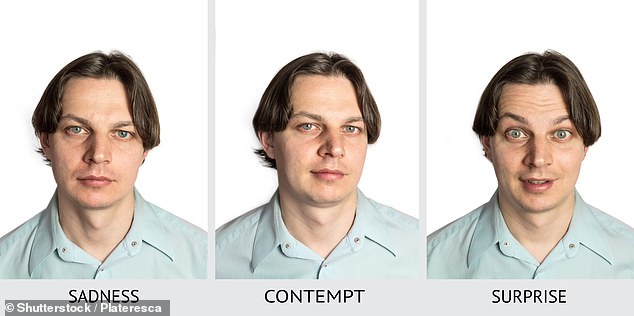Whether you’re in a work meeting or on a first date, it can sometimes be impossible to tell what someone is thinking.
But help is at hand, as experts have revealed the tiny facial microexpressions that can give away a person’s true thoughts.
Even minor changes in expression can convey important messages – from the position of the jaw to the movement of eyebrows.
‘Poker faces are all around us – in job interviews, business meetings, and especially at casino tables – but they’re not always easy to recognise,’ Cormac Moylan, chief marketing officer of the digital game store, Loaded, said.
‘The real challenge lies in uncovering what’s hidden beneath the surface.
‘One key to cracking a poker face is learning to spot microexpressions. These fleeting, subconscious facial movements reveal genuine emotions and are impossible to fake or suppress.
‘While they happen in the blink of an eye, with focus and practice, you can train yourself to pick up on them and gain a deeper insight into what someone might really be thinking or feeling.’
So, whether it’s a flared nostril or a raised eyebrow, here’s how you can interpret these minute shifts in expression.
Surprise
If someone is surprised, their eyebrows are likely to be raised and curved, and you may notice horizontal wrinkles across the forehead, Mr Moylan explained.
‘Without staring, notice if their eyelids are open, with the white of the eye showing above and below the pupil,’ he advised.
‘Their jaw may slightly open, too, but there will be no tension or stretching of the mouth.’
Fear
When a person is trying to hide fear or anxiety, their eyebrows will be raised and drawn together, usually in a straight line.
‘They may also show wrinkles in the centre of the forehead just between the eyebrows – but not across,’ he revealed.
‘Their eyes may have the upper white showing, but not the lower white.’

Tiny facial movements can give a way a person’s true thoughts, indicating whether they’re angry, disgusted or fearful of you (file image)
Disgust
Hiding disgust is difficult – but there are some subconscious facial movements to look out for.
‘The eyes may narrow, and the nose may be slightly wrinkled,’ Mr Moylan said. ‘Look out for a quick flash of the upper teeth, too.’
Anger
If you’re having a heated conversation or perhaps said something out of line in the workplace, there are easy ways to spot if someone is angry at you.
‘Look at the person’s eyebrows, and notice if they are lowered and drawn together, with vertical lines between them,’ Mr Moylan explained.
‘Their lips may also become tense, with corners down, or in a square shape.
‘Another good way to know for sure is if their nostrils dilate.’

An expert said these fleeting, subconscious facial movements reveal genuine emotions and are impossible to fake or suppress (file image)
Happiness
Happiness is the most difficult emotion to fake, and it’s easy to spot a fake smile if you know the trick.
‘Notice if they have crow’s feet near the outside of the eyes, if they don’t, and their lips are open in a smile, chances are they aren’t conveying genuine happiness,’ Mr Moylan said.
Sadness
Sad microexpressions can be difficult to detect – but they usually last slightly longer than others.
The guide suggests looking to see if the inner corners of the eyebrows are drawn in and then up, and the corners of the lips are drawn down.
The lower lip may also very slightly pout out.
Contempt
This is the only asymmetrical microexpression and is one of the easiest to spot – just check if one side of their mouth slightly raises.
If so, it’s likely someone disagrees with your opinion or dislikes you.


